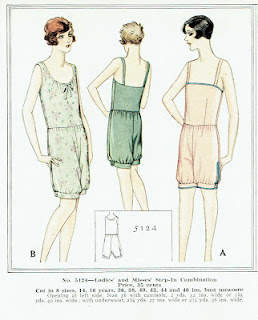I have found a writing group (whoo-hoo!) and have already benefitted greatly after just two meetings. First and foremost, I feel like a REAL WRITER! I'm in a GROUP. And five other people are going to read my stuff and give me feedback! Secondly, of course, are the critiques themselves which provide helpful suggestions and different perspectives. One question that nearly everyone asked about the segment I submitted this week -- the first 3,000 words of the first chapter of the second book -- was "What are combinations?" Prudence has wrapped her real jewelry in her combinations, at the bottom of her bag. Huh? Wrapped them in what?
Although combination underwear was first introduced in the Victorian Era, with knee-length bloomers, the "combinations" Prudence and other flappers wore were basically what we would call a "teddy" today -- a one-piece undergarment that combined (get it? combined -- a combination) the camisole and the drawers in one. They were usually of silk (or rayon or even cotton for the rest of us) and were worn by younger women, just as teddies are today. Older women might still be wearing the Victorian combinations that they donned as young women or a corset and bloomers.
Why "combinations?" Why plural? For the same reason we say "panties," "shorts," or "drawers" ... which, according to the Encyclopedia Britannica is because the words are "plurale tantum. The Oxford English Dictionary defines plurale tantum, which is Latin for “plural only,” as a “noun which is used only in plural form, or which is used only in plural form in a particular sense or senses.” Bifurcated items (things that can be divided into two), such as pants, fall into this category. Think of items that are usually referred to in plural—often preceded by “pair of” or something similar, even when there is only one item: pliers, glasses, scissors, sunglasses, tweezers, etc. So, pants is a type of noun that is used only in its plural form, even when there is only one item being discussed." https://www.britannica.com/story/why-do-we-say-a-pair-of-pant
I will note that not every site uses the plural, but every work of fiction that I've read from the period does -- if it mentions such things. Most don't.
Why wear combinations? It gave a nice smooth line under those tubular silk dresses they wore. The same reason that women wear bodysuits and teddies today.
There are dozens of examples all over the internet. Sometimes they are called "step-ins" because, you know, you stepped into them, or "cami-knickers," but that sounds very British to my ear. One site says that they were called a "chemise," but that would be a what we today call a full slip or a camisole, as in the photo below on the right (your right).

